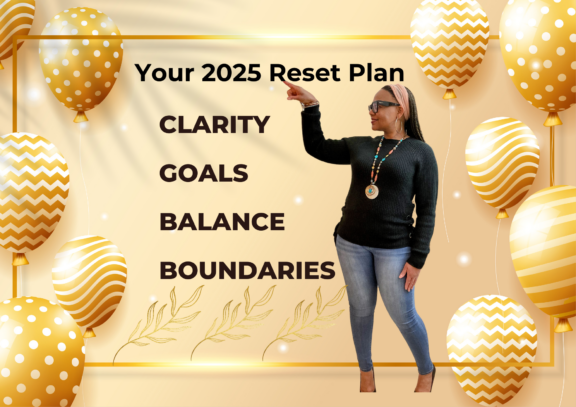How Food Impacts How You Feel
So, Thanksgiving and Christmas have both come and gone. Think back to your Thanksgiving or Christmas meal- a large spread of food that likely included a ham, a smoked turkey, fried chicken, collard greens, cornbread dressing, macaroni and cheese, candied yams, sweet potato pie, peach pie, german chocolate cake, red velvet cake…the works! Is your mouth watering yet? I imagine that it is. Now, think back to how you felt after you were done eating. You probably felt overly satisfied, stuffed, heavy, and perhaps ready to settle in for a nice, long peaceful nap. How do you think you’d feel if you ate this way every single day of the week? You might be a bit on the unproductive side, not much energy to really do anything but curl up on a cozy sofa for some serious resting. Although this type of eating feels so good to the soul, and it does often have its place, comfort eating is not ideal for everyday indulgence due to the high calorie and carb contents it has, which is the reason for that lazy, sluggish feeling after you’re done eating.
The Energy Boost of Balanced Eating
Compared to the “heavier” high calorie-high carb eating, think about how you feel when you eat a healthy-light meal packed with fruits, vegetables, and lean meats like a nice and fulfilling green salad with some form of meat protein, or even just a simple balanced meal? Chances are, you probably feel energetic, light on your feet, and less tired.
We all know that healthy food choices are better for you when it comes to your overall health and wellness. It’s all a part of mindful eating-making those conscious decisions about the healthier foods we choose to eat more often than not. The more you prioritize healthy eating, the better your body tends to function. When we do this, the benefits could be that we feel:
- Less heavy, sluggish, and weighed down
- More energetic
- Mentally clear and focused
- Balanced and refreshed
These healthy eating habits can produce a domino effect in your life and in your health. If you are beginning to eat healthy, you may think twice about ruining it with a 10-piece lemon pepper wing meal and washing it down with a large sweet tea. To keep that healthy eating momentum going, you may decide on a more balanced choice like a rotisserie chicken with rice and veggies. Also, when you start eating healthy, you may decide to take it up a notch and incorporate some form of exercise into your routine to compliment your healthy food choices. Why would you choose to eat healthy and just stop there-or exercise and then scoff down unhealthy meals on most days? This is a rhetorical question that should not be answered, but pondered upon because we’ve all done it at some point or another. Let’s make our decision of choosing to eat healthy turn into a full-fledged lifestyle that includes healthier food options along with regular exercise, creating a true win-win that will bring us into a positive shift for our overall health and well-being.
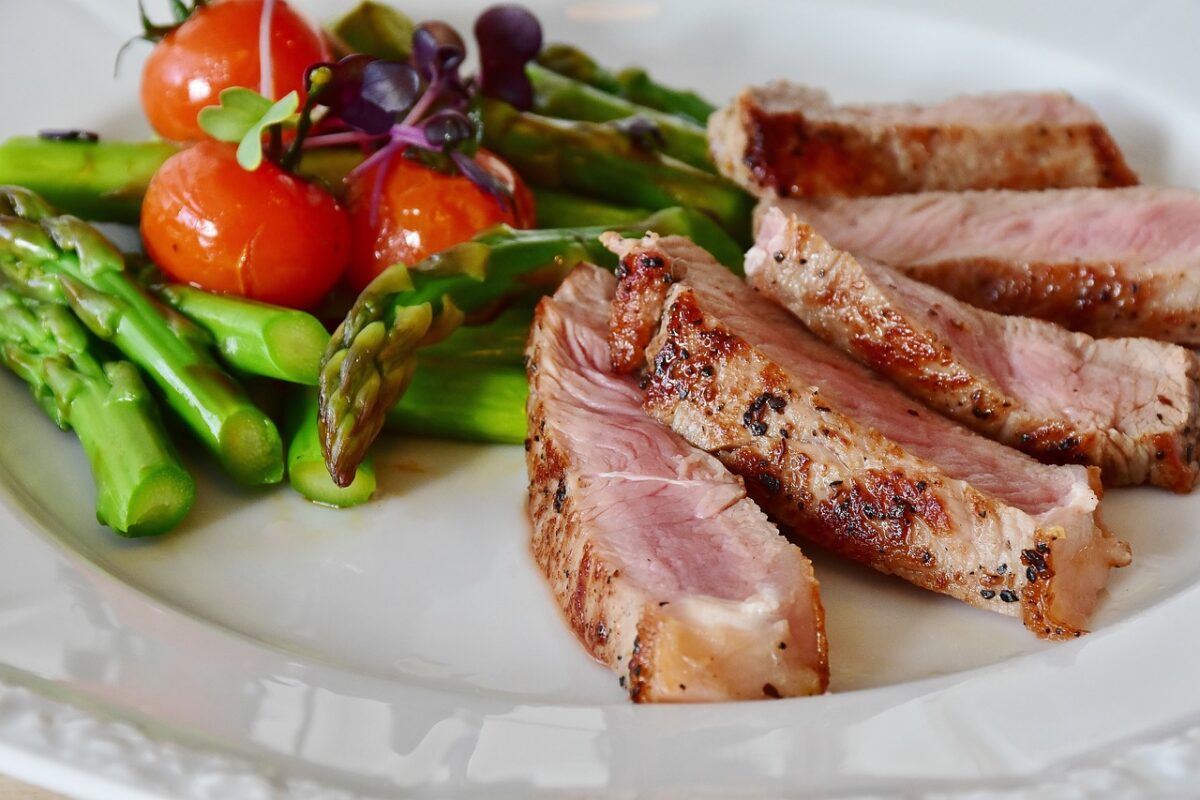
Healthy Eating As A Form Of Self-Care
Self-care can take on many forms and come through any activity we engage in. Changing your eating habits is no exception—it’s a powerful form of self-care, showing that you value what you are putting into your body and remain mindful of how it impacts your well-being. Healthy eating often brings peace of mind, unlike the guilt or stress that can follow after consuming unhealthy food choices. When you prioritize nutritious options like fruits, vegetables, and lean proteins, you feel confident about their positive impact on your health. Think about those times you’ve indulged in a high-calorie, high-carb meal and later regretted it—did it leave you feeling like you should’ve chosen something a little bit more on the healthier side? This is because you’re fully aware that choosing healthier foods is a far more effective way to support your self-care than indulging in unhealthy options.
Thinking back once again to that feeling you feel after you’ve eaten a healthy and well-rounded meal compared to other unhealthier food choices-this energized and satisfying feeling is the goal we should strive for when we eat most of our meals-feeling good about what’s going into our bodies. The importance of healthy eating not only impacts our physical well-being, but it can also have a significant impact on our mental and emotional health as well. When I was coming up, we’d have Sunday dinners that kind of resembled mini Thanksgiving Day meals. The smell of the food was so tempting that I just couldn’t wait to eat. The food was always great and very satisfying, however, I would notice that after dinner was over, the only thing I wanted to do was sleep, and I sometimes felt a bit down afterwards. I initially attributed this to overeating, but the truth is, those meals were packed with high amounts of fats, carbs, and calories, leaving me feeling sluggish and weighed down instead of active and energized.
Don’t get me wrong, as I said before, there is absolutely nothing wrong with enjoying comfort foods or indulging in meals high in fats, calories and carbs every now and then. They definitely have their place in life’s indulgences, however, they are best enjoyed occasionally and not as a daily, or near daily habit.
Two Healthy Recipes To Get You Started
Adopting healthy food goals into your daily routine doesn’t have to be boring. A lot of times when we think of eating healthy, we think about foods that are bland to the taste, uninspiring, and very unappealing to our senses. Another common obstacle is the cost of healthier options, especially with the rising costs of groceries these days. We all know what it’s like taking a trip to the grocery store and dreading the checkout line. We wrestle with ourselves because we know that we should grab more fruits and veggies, but because of the high grocery prices, we are tempted to reach for more budget-friendly options that may not always be the healthy food choices we need. I am going to share with you two simple healthy recipes that you can mix and match and also have them for all three meals at least two to three days out of the week. I’ll also share with you how much the ingredients are so that you’ll be able to see that you can still eat healthy most days of the week on a budget.
Recipe #1-Banana Berry Smoothie
The first recipe is a Banana Berry Smoothie. This smoothie is packed with nutrients that are rich in fiber and antioxidants like vitamin C which boosts your immune system and supports skin health, vitamin B6 which supports brain health and promotes a healthy nervous system, and vitamin K which plays a role in blood clotting and bone health. The banana berry smoothie is great for boosting energy levels, helps to maintain a healthy blood pressure, and it’s a great way to start your day, ensuring that your servings of fruits and vegetables will be met in this morning meal. Here is the recipe to help you put it together.
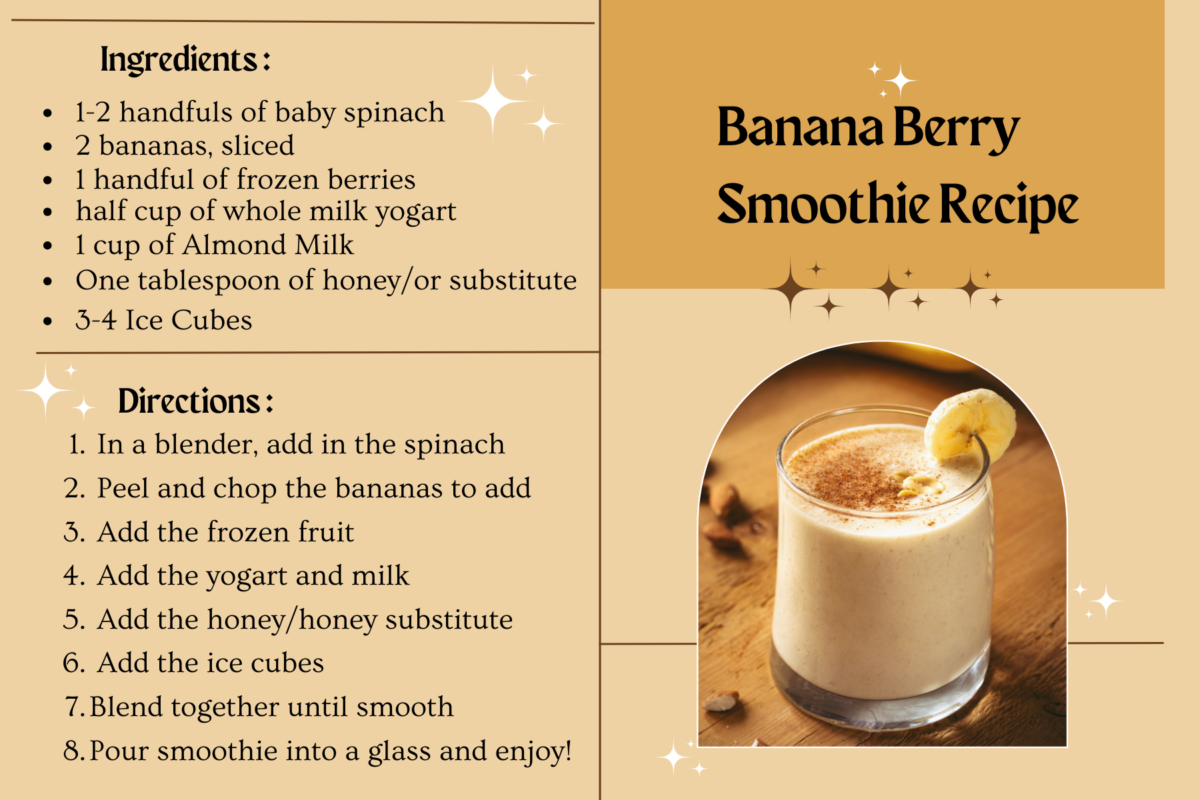
In order to create this smoothie and many others, you will definitely need a good blender. A blender is essential not only for making healthy and delicious smoothies, but you can also use it to make great tasting shakes, soups, salad dressings, pancakes, frozen treats, etc. Interested in purchasing a blender to try out this smoothie recipe? Check out this one to see if it fits your budget, wants or needs. Click the link below to learn more about this product from Amazon.
Recipe #2-Breakfast Salad
You’ve probably never thought about having a salad for breakfast, but I’m here to let you know that it is perfectly fine to start your day with a nice healthy salad for your breakfast meal. Beginning your day with a breakfast salad can set you up with a wide range of vitamins and minerals first thing in the morning, supplying you with a healthy dose of fiber, iron, and antioxidants. This recipe can help you maintain a healthy body weight, supports heart health, and increases your energy levels. The breakfast salad can also be eaten for lunch or dinner. Be creative with it! Here is the recipe to help you put it together.
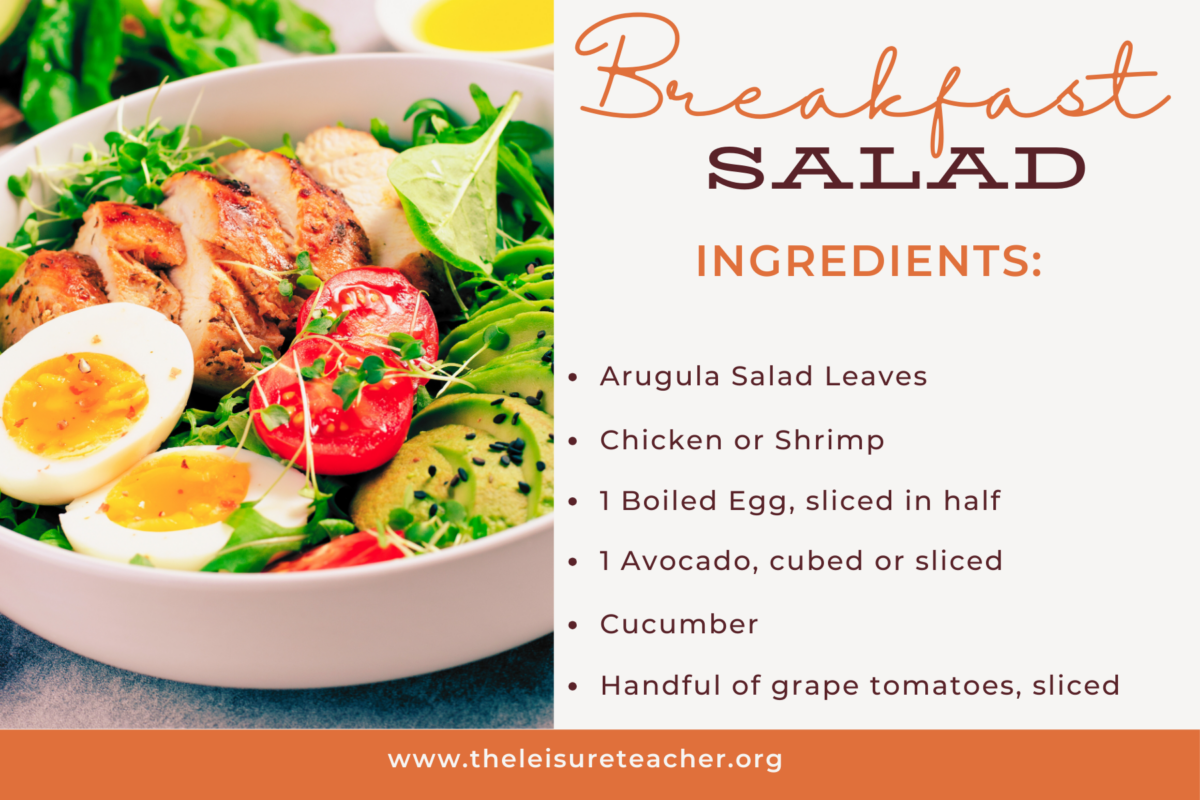
Below is a grocery list to purchase the items needed for putting these healthy meals together. In the grocery list, I have also included items for a healthier option-homemade salad dressing as well.
For the homemade salad dressing, the amount you need will depend on the size of your salad and how many days you plan to include this as a meal. For a single breakfast salad, here are the ingredients and simple steps to bring it all together:
- 3 tbsp Olive Oil
- 1 tbsp Balsamic Vinegar
- 1 tbsp Lemon Juice
- 1/4th tsp Salt
- 1/4th tsp Black Pepper
Whisk all ingredients together or shake well if you are preparing it in a mason jar. Pour the salad dressing mixture into a bowl before dressing your salad. Leave a small amount of the dressing to pour over the salad toppings. Put your salad leaves on top of the salad dressing mixture. Toss the salad leaves, allowing the leaves to slightly soak up the dressing. Add your choice of protein along with a boiled egg cut in half. Slice or dice up an avocado and some cucumber. Slice up a handful of grape tomatoes. Drizzle the toppings with a small bit of the remaining dressing. Serve it up, eat, and enjoy!
Here is a grocery list of all the items you’ll need for both recipes. These recipes are very versatile and can be mixed and matched for any meal-breakfast, lunch, or dinner. Remember that healthy eating does not have to be boring, it can be as fun and exciting as you make it. It is quite alright to eat for comfort some days, but on most days, I challenge you to eat for your health and also for your self-care journey. So, here’s to you and your new healthy lifestyle change, enjoy!
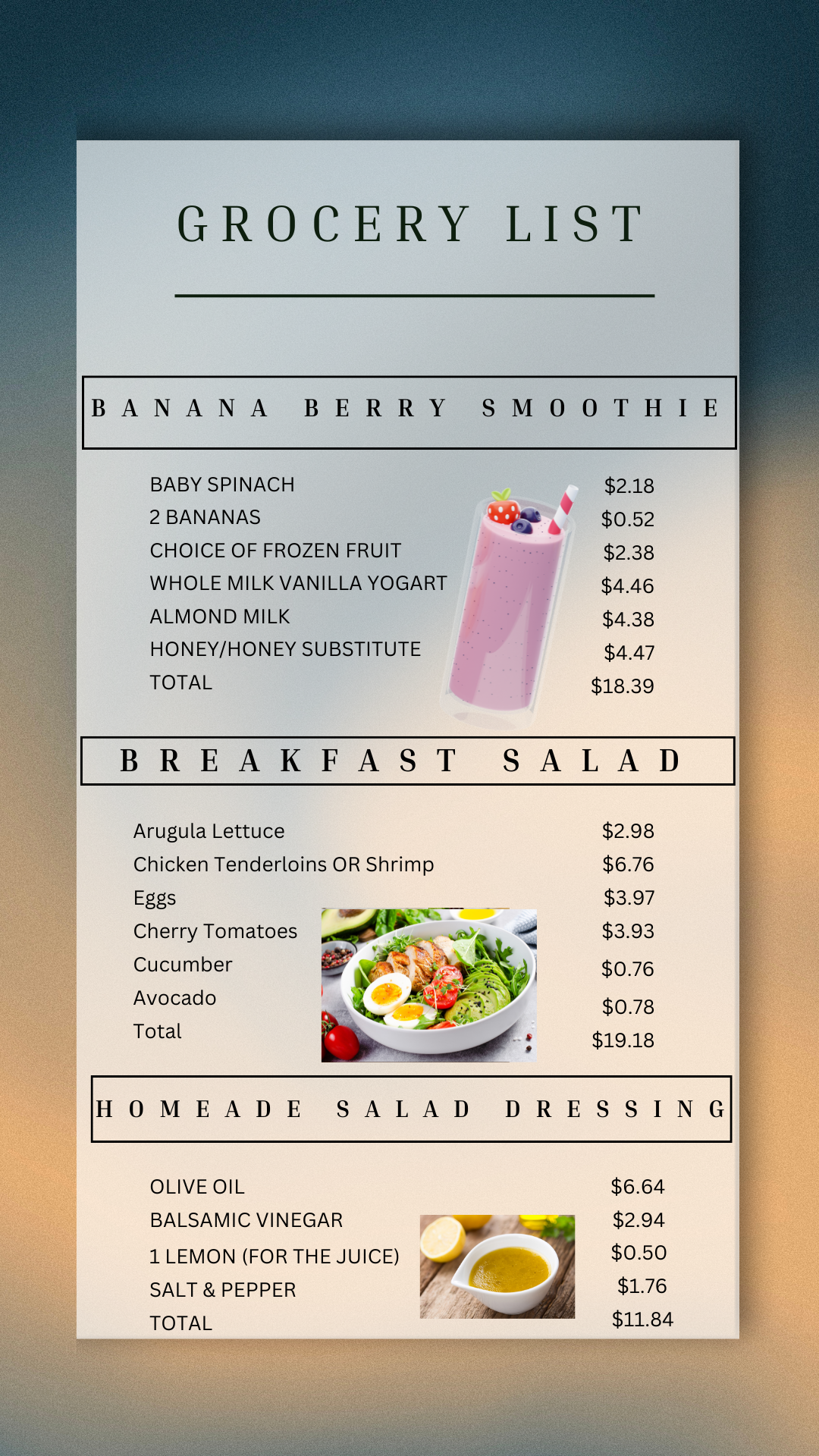
This post contains affiliate links. If you make a purchase through these links, I may earn a small commission at no additional cost to you. Thank you for supporting my blog!







